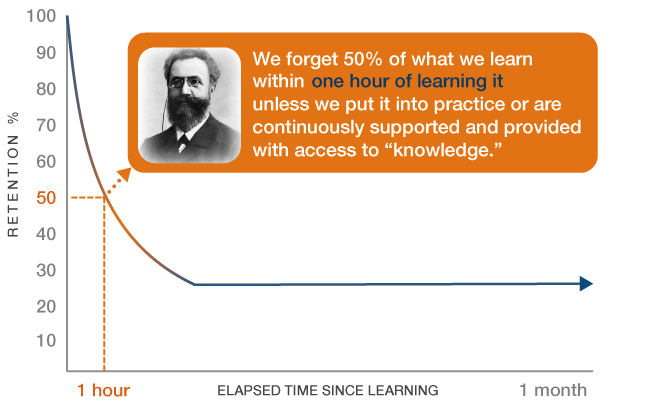eLearning: Overcoming the Forgetting Curve
- No Comments
The human mind is immensely complex, at times capable of amazing feats of intellectual mettle, yet seemingly fragile and forgetful in other circumstances. Great educators overcome this contrast through genuine connection, striving to bring out the best in their learner. This theme rings equally true within the eLearning realm. How do you tap into your learner’s potential and truly leave the forgetting curve behind?
A study by psychologist Hermann Ebbinghaus shows us that memory retention declines over time and that the rate in which we forget information is exponential. The initial period after learning new information is when we forget the most; almost 60% of newly learned information is forgotten in the first couple of days.
It is vital to keep this forgetting curve in mind (pun intended) when designing your online training course or eLearning content. In fact, when done right, eLearning provides a uniquely effective tool for combatting the forgetting curve, allowing you to engage a learner across a multitude of stimuli. However, this relies on your ability to design your course in such a way that information is portrayed clearly, frequently, and in a concise manner.
We have found that the most effective training courses all share similar traits:
- Course objectives are well-defined and plainly state how the learner will benefit from learning the presented information
- Long lessons are broken into multiple modules; individual modules are at most 15-25 minutes long and should avoid running longer than 30 minutes.
- Courses are concise; too much “fluff” can have a serious impact on the learner’s ability to focus on the meaningful core content. Before adding content to your eLearning module, always ask yourself, “How does this content teach and reflect my learning objectives?” Presenting information with a purpose allows for more retention and easier recall in the future.
- The information is given meaning and relevance to the learner when it is delivered in a work-related context. More information is retained when the brain links a reason for it to be remembered.
- The content engages the learner with multimedia (animation, graphics, narration, simulation) and exercises like short quizzes or gamification. When designing multimedia, consider the varying learning styles of your audiences, accounting for kinesthetic, auditory, and visual preferences.
- Review, review, review! Important concepts are repeated multiple times in various formats throughout the course. This makes memory of the information stronger and more easily recalled in the future.
- Training is evenly distributed to keep the information practiced and current, rather than held as an annual training session. Ebbinghaus found that relearning known information is more effective than learning information for the first time.
Incorporating these traits into the design of your eLearning content or online training course will improve the efficiency of your course and its impact on a learner’s ability to retain the information. Remember the forgetting curve!



